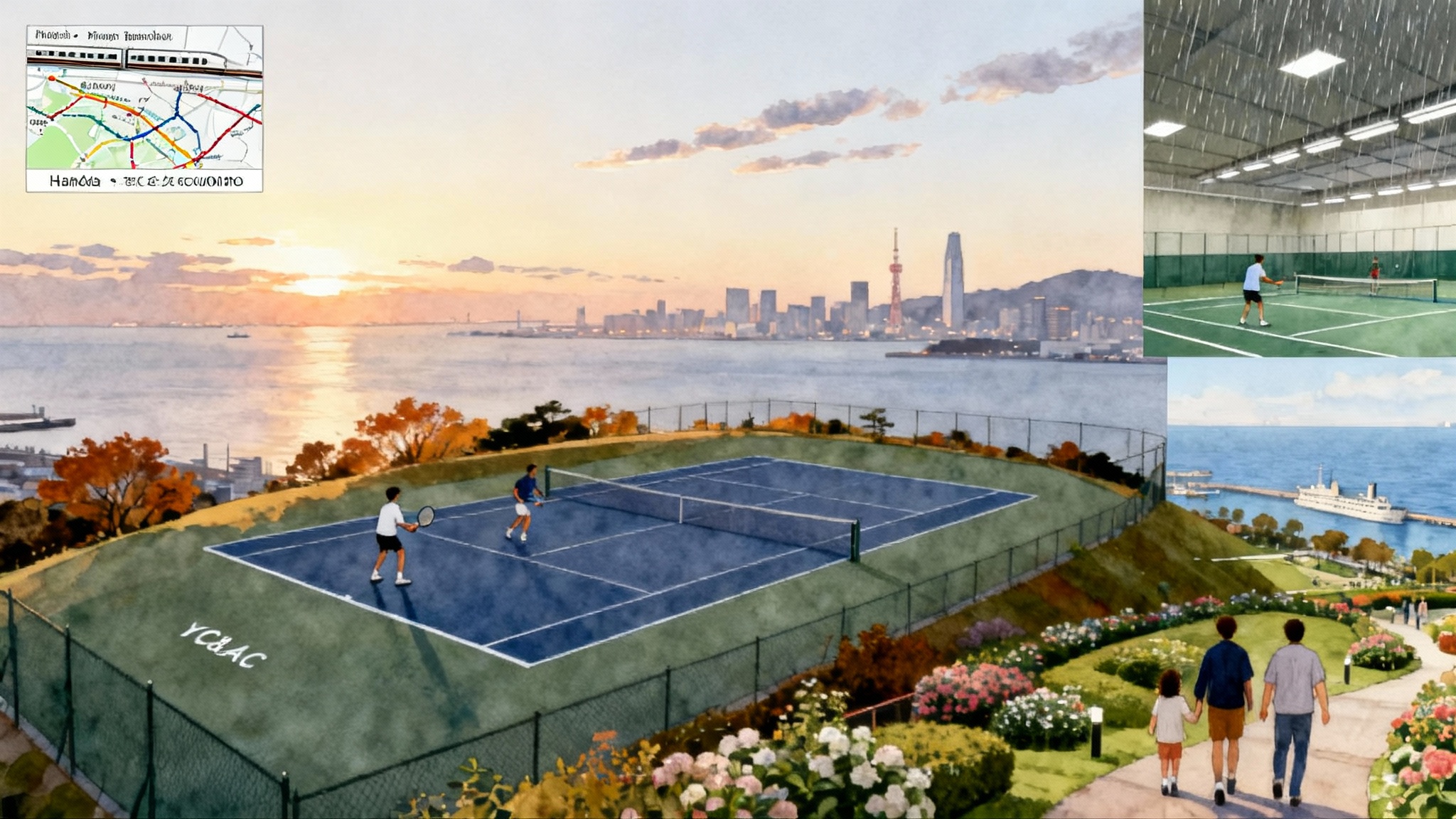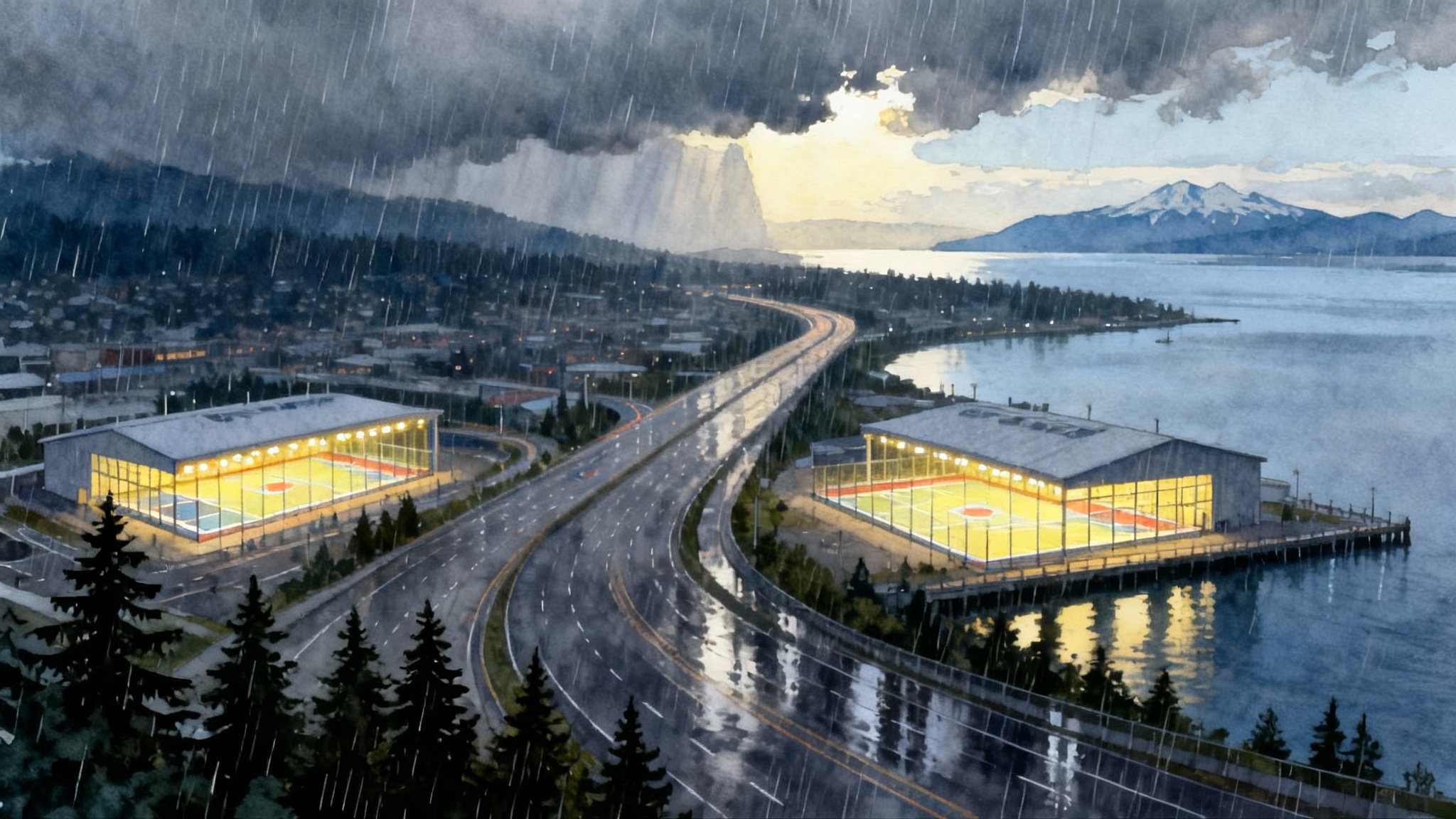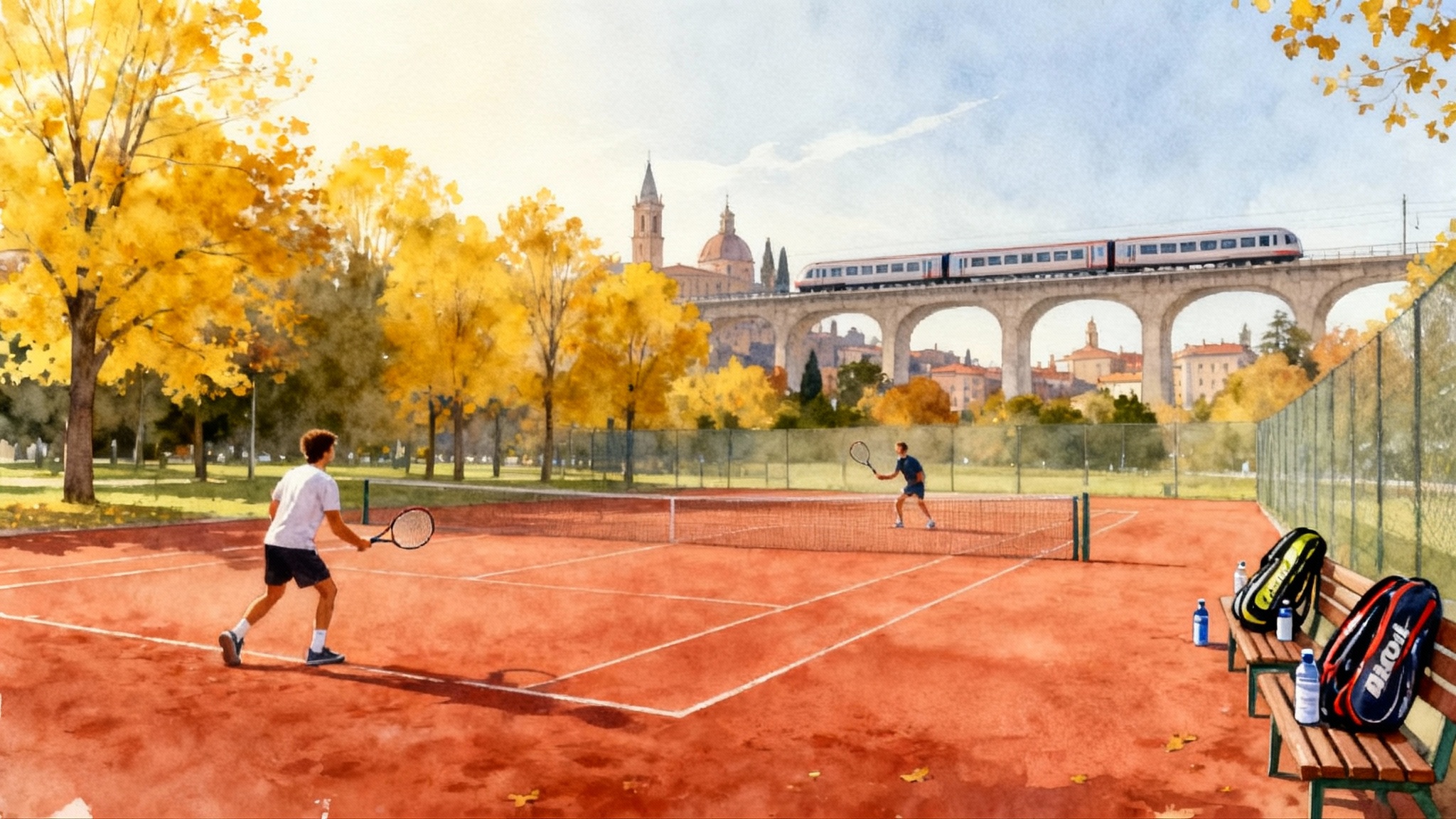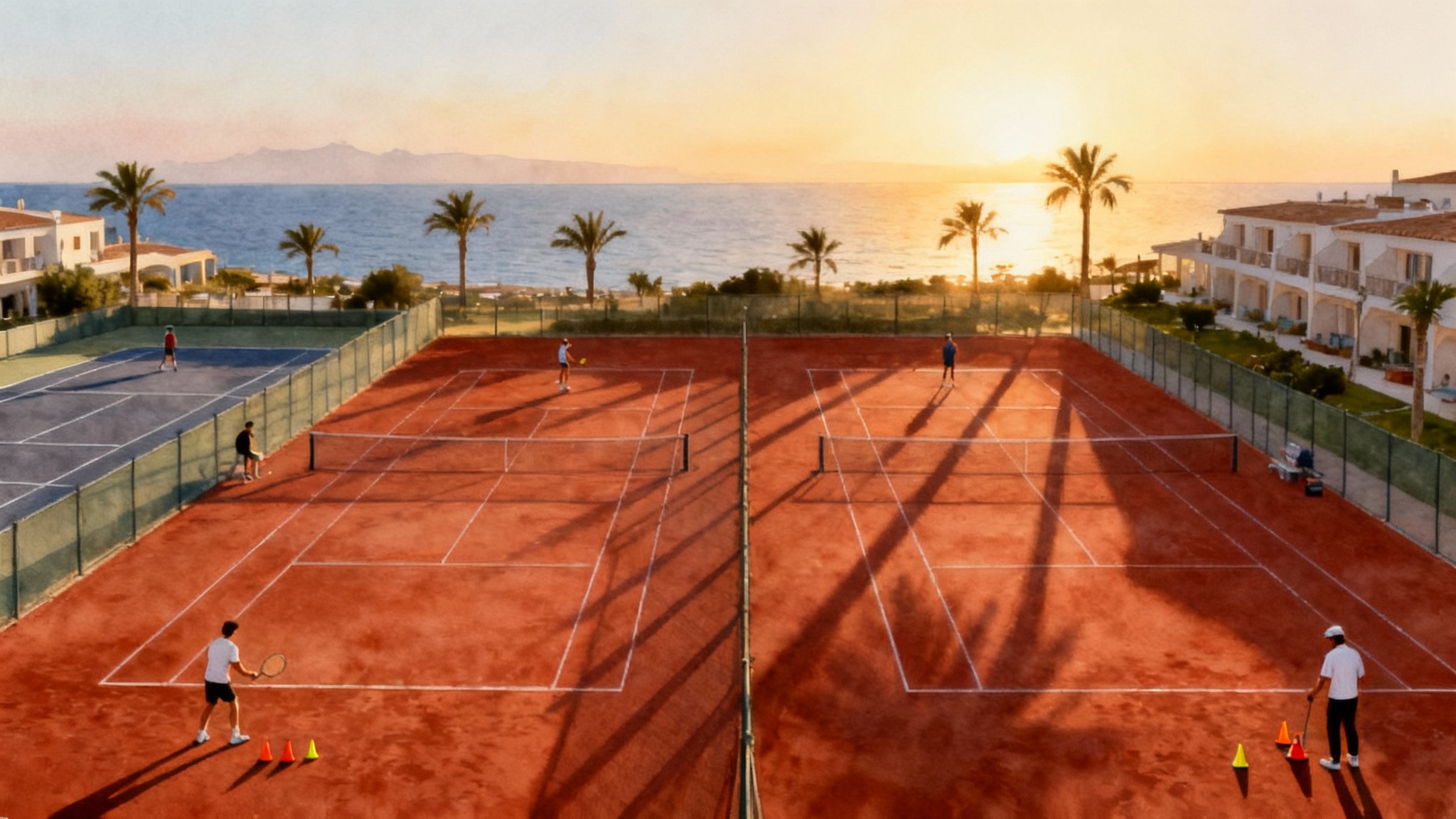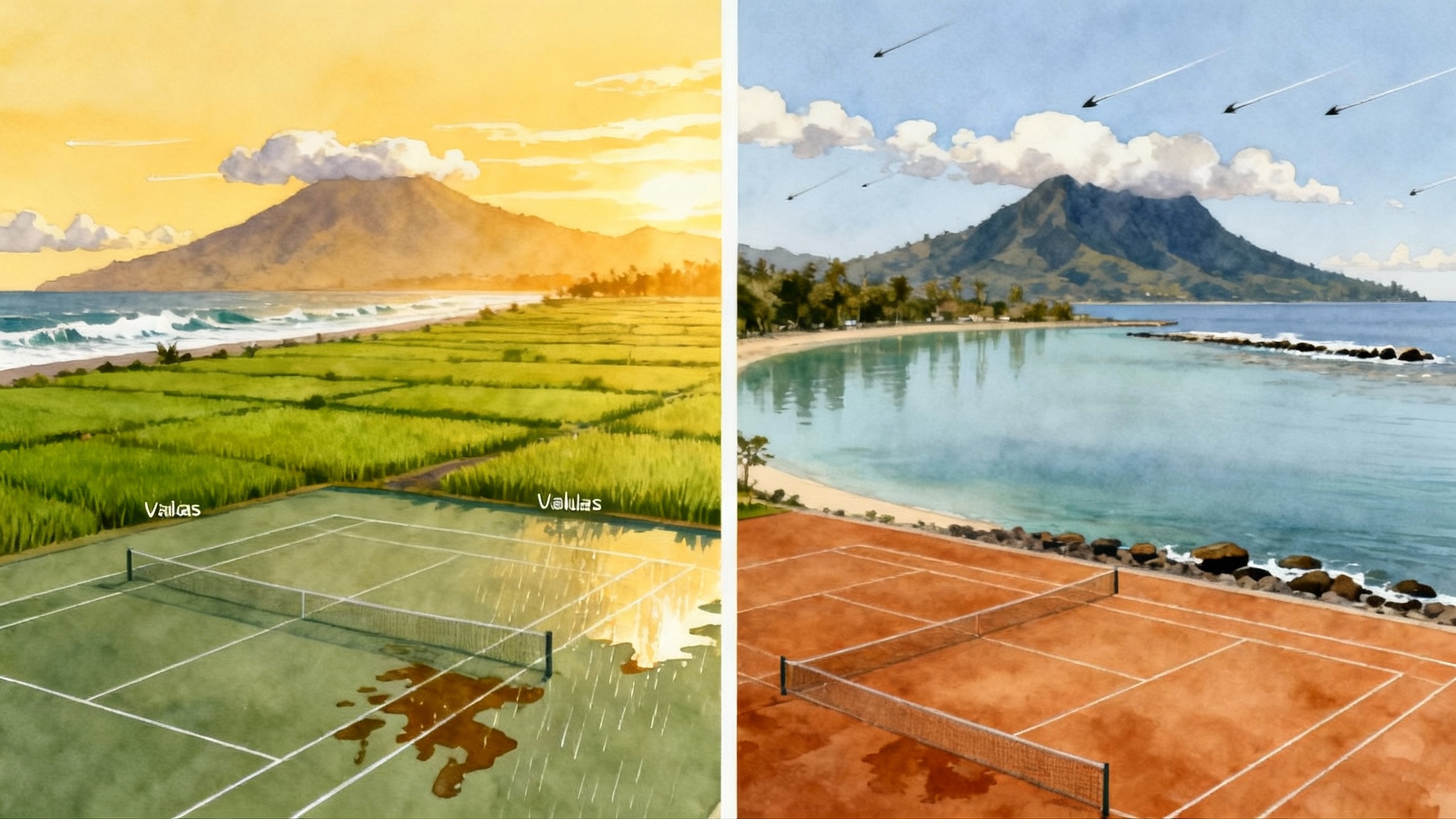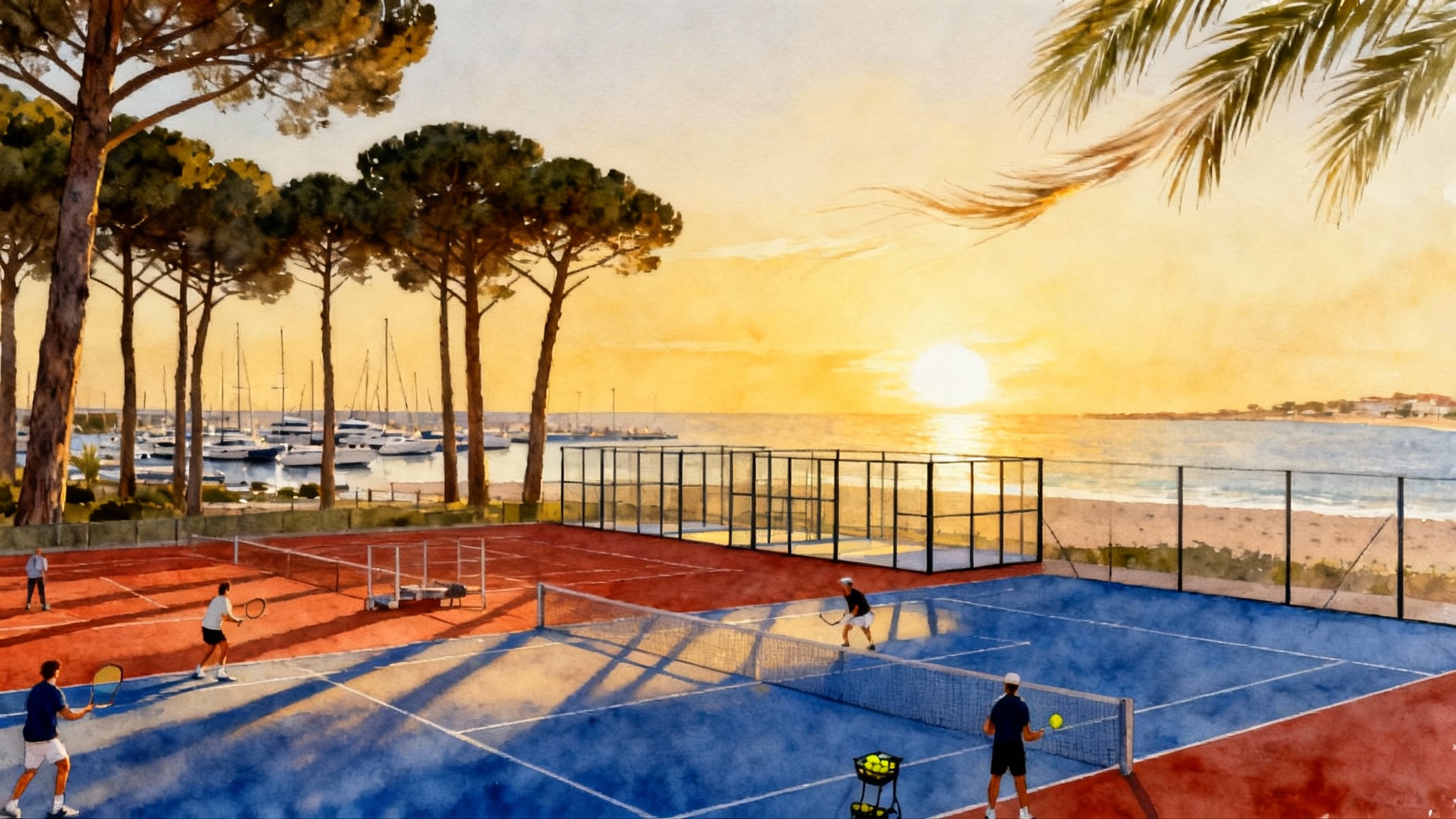Indian Wells Desert Tennis Guide 2025–26: BNP Playbook
A climate-smart guide to training and travel in the Coachella Valley from October to April. Learn how dry air, sun angle, and winds change ball flight, when to train, how to tune strings, and where to book quality clinics.
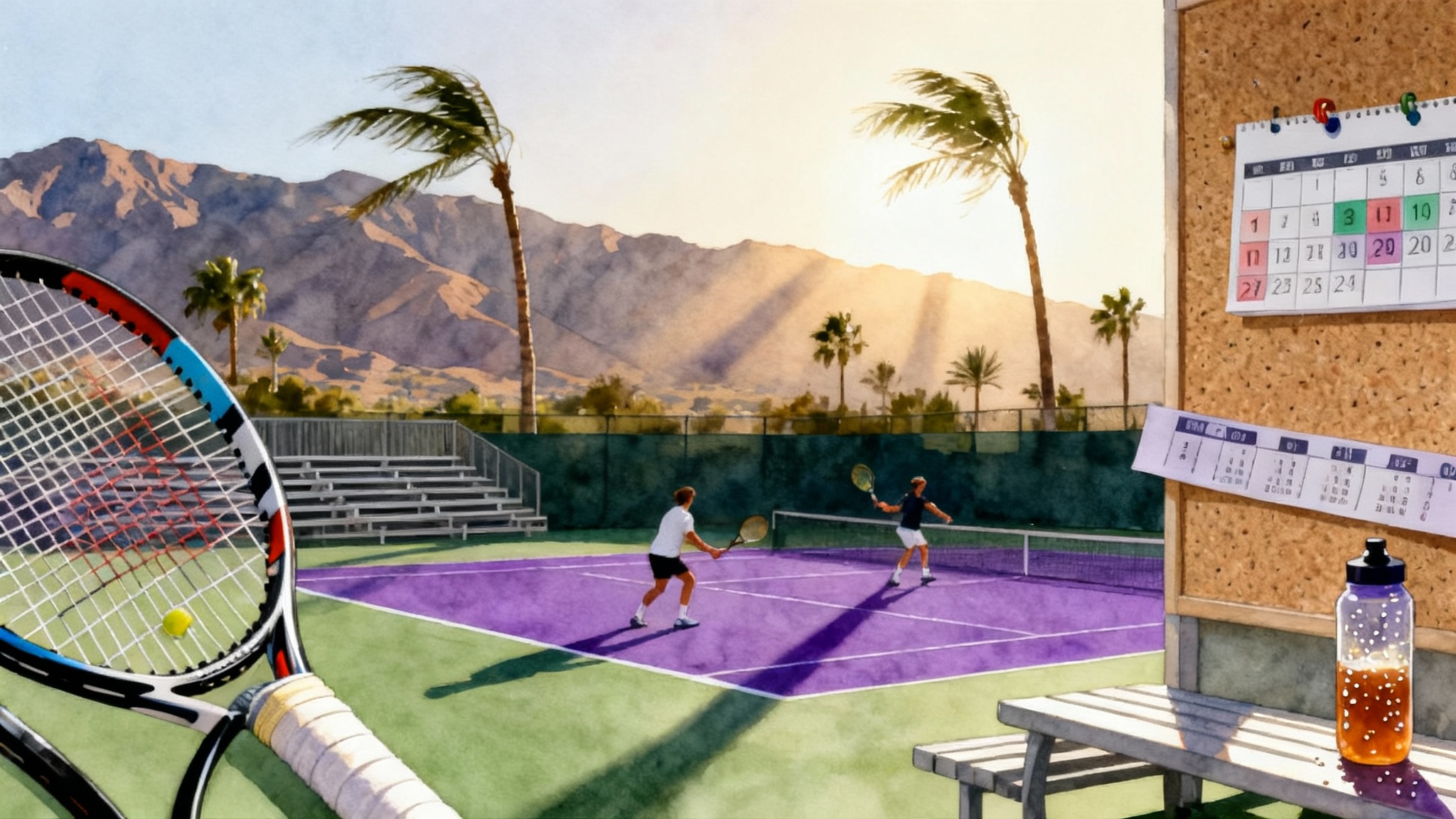
Why the Coachella Valley plays differently from October to April
From October through April, the Coachella Valley gives tennis its own kind of physics. The air is dry, mornings are cool, afternoons warm quickly, and the wind often sneaks in after lunch. If you understand what the desert does to the ball and to your body, you can plan smarter practice blocks, pick smarter match tickets, and come home playing better than when you arrived. For a coastal contrast in similar months, compare conditions in our Santa Cruz–Monterey marine-layer guide.
The BNP Paribas Open turns March into a festival of tennis at Indian Wells. Before you set dates, confirm the event window using the tournament’s official schedule and tickets so your practice blocks line up with day and night sessions.
Dry air and why your ball flies
Desert air has low humidity, which means fewer water molecules mixed into the air. Less moisture lowers overall air density, so the ball meets slightly less resistance as it travels. The effect is subtle but noticeable over a full session. Players often say the court "plays quick" even when the surface is medium. Expect your flatter drives to carry a bit farther and your serve to feel a touch livelier. Topspin still bites, but with less drag the arc can lengthen, so balls that usually dip just inside the baseline may float long unless you shape them more aggressively.
A simple cue: on your first basket, aim your rally ball two feet shorter than usual and adjust with net clearance rather than raw pace. You will find length faster and avoid early errors that can disrupt rhythm.
Sun angle and what your eyes see
In winter the sun sits lower for more hours of the day. Morning sessions point glare directly across many east–west resort courts. In late afternoon the sun can hang in the toss window for a righty serving on the north baseline. Pack a baseball-style cap with a darker underside on the brim, and practice a slightly lower toss that still lets your hitting shoulder fully rotate. If you struggle to see the ball on overheads at 4 pm, bias your session earlier or shift to crosscourt feeds that avoid staring into the light.
Afternoon winds and how to live with them
Most days are calm in the morning. As the valley warms, wind often pipes up, especially near the San Gorgonio Pass and in exposed complexes. The wind rarely blows one way all day; it pulses and swirls off the surrounding mountains. If you plan a quality technical session, book it in the morning window. In the afternoon, reframe the wind as free skill training. Play crosscourt patterns that accept drift, practice heavy roll against the wind, and work lower, flatter drives with the wind. On serves, shrink your toss window, hit more body targets, and add kick into the wind to buy margin. If you want an indoor-heavy comparison for winter travel, see our Seattle–Vancouver indoor corridor guide.
Temperature swings and the “two-court” day
Desert mornings can feel like a different court than midday. Cold air is denser, balls feel firmer, and strings feel a bit tighter. By early afternoon the court speeds up. When you plan a long day, think of it as two courts. Do your precision drills early when you can feel the ball longer on the strings. Put point play and fitness in the afternoon when conditions challenge your footwork and decisions.
Timing your sessions for skill and recovery
Morning blocks for quality reps
- Best for: technique, serve targets, footwork ladders, return timing, controlled live ball
- Why: calmer wind, softer light, cooler felt and strings behave predictably
- How: start with 15 minutes of high-contact warmup, then stack your highest priority drill first, before fatigue and heat dull decision making
Midday blocks for resilience and match skills
- Best for: pattern tolerance, first-strike plays, situational games to 7 or 11, serve plus one, return plus one
- Why: the ball moves a bit quicker, which stresses spacing and balance in match-like ways
- How: shorter sets with longer changeovers. Use shade for coaching notes
Late afternoon for wind craft or active recovery
- Best for: wind-specific skills, touch work, slice, drop shots, volley patterns, fun doubles
- Why: if the breeze shows up, you get real problem solving. If it does not, the light is nice and the heat eases
- How: set constraints. For example, in a crosswind, play only inside-out on the upwind side and only down the line on the downwind side. Your aim will tighten fast
Hydration, fueling, and heat sense in the desert
Dry air hides sweat. You lose fluid quickly without seeing it drip. Build a simple routine:
- Prehydrate at breakfast. Add a pinch of salt or an electrolyte tab to water if you are a salty sweater.
- On court, sip every changeover. Think small, steady sips rather than big chugs. Add electrolytes during longer midday sets.
- Use a white towel to check sweat salt. If you see visible salt rings on shirts or hats after sessions, increase sodium in your drinks and meals.
- Post session, weigh yourself before and after hard practices once or twice during the trip. If you are down a pound, replace roughly 16 to 20 ounces over the next hour, plus electrolytes, and include protein with carbs in your next meal.
Sleep is your top recovery tool. The desert’s cool nights help. Keep the room on the cooler side, stretch calves and hip flexors for 5 minutes, and set shoes out to dry so the midsole rebounds fully by morning.
Strings, tensions, and gear that travel well to Indian Wells
Dry, quick conditions reward spin, timing, and control. You can make small, smart changes without reinventing your setup.
Tension tweaks by time of day
- Cool mornings: drop 1 to 2 pounds to add dwell time and depth. If you use stiff polyester, the softer feel helps you brush with confidence when your arm is not fully loose.
- Warm afternoons: raise 1 pound for control if you tend to overhit. If wind is up, a small increase can tame launch angle without forcing slower swings
String types and gauge
- Polyester mains with a softer cross give spin and comfort. A 17 gauge in the mains snaps back easily in dry air and keeps RPMs high.
- Full multifilament or a gut hybrid feels great in the morning but can get lively later. If you love that feel, protect control with a slightly thicker gauge or fractionally higher tension.
- Re-string sooner than at sea level. Dry conditions and bright sun fatigue strings faster. If you stay a week and play daily, plan a mid-trip restring
Grip, shoes, and balls
- Bring extra overgrips. Dry air and frequent hand sanitizer use can make the grip feel slick by day three.
- Shoes with solid lateral support matter when wind nudges you off balance. Rotate pairs so foam rebounds.
- If you practice with pressureless balls for volume, mix in fresh pressurized balls before match days so your timing matches what you will feel in the stands
Where to book high-quality clinics and short camps
You are spoiled for choice. The valley’s major resorts run strong programming. Indian Wells Tennis Garden schedules clinics and live ball, especially during the event. La Quinta Resort and Club offers daily sessions on a picturesque campus. Omni Rancho Las Palmas and JW Marriott Desert Springs host group and private options. Hyatt Regency Indian Wells and other properties round out the map. Availability and staff rosters change seasonally, so verify the weekly calendar when you book your stay.
If you want a structured Southern California option during your visit, consider this nearby base: the Tustin Tennis Academy overview.
Pro tip when comparing clinics:
- Look for a posted theme, not "open live ball" every day
- Ask for a ball-to-player ratio and how many balls each basket holds
- Confirm the coach-to-court ratio, especially during BNP week when demand spikes
- Favor sessions that build across days, for example serve plus one on day one, return plus one on day two
Itinerary ideas that link event days and purposeful practice
Below are plug-and-play schedules you can adapt to your ticket times and energy. Swap in rest or spa time where your body asks for it.
Three-day opener: arrive, groove, and watch
Day 1
- Morning: arrival mobility, 60-minute hit to set contact height, 20 minutes of serve targets
- Midday: pool and nap, light lunch with salt and fruit
- Late afternoon: grounds stroll to learn the venue flow, watch practice courts, one night session match
Day 2
- Early morning: 90-minute clinic focused on patterns. Ask the pro to finish with first-strike games to 7
- Late morning: recovery snack and shade
- Afternoon: day session show court seats; take notes on patterns you trained in the morning, especially second shot choices
Day 3
- Morning: 75-minute private or semi-private lesson, film 10 minutes of serve and return
- Afternoon: doubles hit in the wind to stress communication. Head to a night session if energy is good
Five-day middle rounds: skill block plus big matches
Day 1
- Morning: technical lesson on forehand height control. Cue: two net cords of clearance, depth through spin not pace
- Evening: rest, watch on TV, early sleep
Day 2
- Morning: serve plus one and return plus one patterns. Use cones for depth targets
- Afternoon: day session matches, one hour in the player practice area to study footwork between shots
Day 3
- Recovery morning: light mobility, 45-minute feel-only hit. No point play
- Night: prime-time matches
Day 4
- Morning: wind craft session. Upwind side, higher arcs. Downwind side, lower strike zones and body serves
- Afternoon: doubles clinic for variety
Day 5
- Morning: match simulation to 2 short sets with tiebreaks. Keep score, use changeovers, and hydrate like a real match
- Evening: dinner, pack, gentle stretch
Finals weekend: sharpen and savor
- Friday: 60-minute high-intensity feed session, finish with serve tiebreaks to 7
- Saturday or Sunday: arrive at the venue early, watch a practice, walk the grounds, then settle in for the big show. If you can, book a recovery hit the morning after to capture what inspired you
Month-by-month sense of conditions
- October: warm afternoons are common, with crisp mornings. Schedule technique early and pattern tolerance late
- November to December: cooler, calmer feel, great for volume. Nights can be chilly; bring a light layer for evening matches
- January: the coolest month. Balls feel firmer at 8 am. Keep swings full and consider a 1 to 2 pound tension drop
- February: trend toward warmer afternoons, more match-like speeds. Wind days start to pop up
- March: BNP month, lively atmosphere, more crowds. Plan travel time to and from the venue and expect higher demand for courts
- April: shoulder season warmth picks up. Hydration and sun management become central again
Venue logistics that save time and legs
Parking, walking routes, and where you sit change your energy curve. Learn the layout before your first session in the stands. The tournament posts a helpful venue map and policies. Choose a meeting point with your group before matches so you are not texting in the sun. If you can, watch a top player practice for 20 minutes. Observe their return depth on second serve and how they recover after wide balls. Then copy one detail that fits your game on your next court time.
If you stay in Indian Wells or La Quinta you are within a short drive to most resort courts. Palm Desert central has lots of dining and easy access to clinics. Palm Springs proper adds midcentury cool but a bit more drive time to Indian Wells. Rush hour is not intense compared to big cities, but factor in event traffic near first ball times.
Tactical tweaks for desert tennis
- Serves: practice a lower, more forward toss for your flat and slice, and a slightly higher toss for kick when you face the wind
- Returns: start a half step farther back at noon if you are sailing returns long, then walk forward after contact
- Groundies: in the breeze, bias inside-out forehands to the big part of the court. Down the line is a weapon, not a habit
- V o lleys: punch through the center of the strings and play deeper targets. The ball will come to you fast at net; do not over-carve
- Lobs and overheads: hit topspin lobs into the wind and slice lobs with the wind. For overheads, turn the shoulders fast and keep the left arm pointing to the ball a beat longer to track in bright light
Packing list that earns its space
- Two caps, darker underside on the brim for glare
- Sunglasses with a sport nose bridge that does not bounce
- Sunscreen you trust, lip balm with SPF
- Two pairs of shoes to rotate
- Extra overgrips and a second set of strings pre-cut to your frame
- Electrolyte tabs or powder, soft flask or bottle you like to carry
- Light long-sleeve for early mornings and night sessions
- Small notebook for patterns and match notes
A desert plan that sticks
Indian Wells rewards players who plan like locals. Use cool mornings for clean technique and serve targets. Treat breezy afternoons as a free coach that makes you smarter. Nudge tension a pound or two when conditions change. Book clinics that build skills day to day, then pair them with matches that show you how the greats solve the same problems. When you fly home, you will not just have watched world-class tennis. You will have built it into your game, one well-timed session at a time. For more California training ideas, check the Santa Cruz High-Performance Tennis Academy overview.
